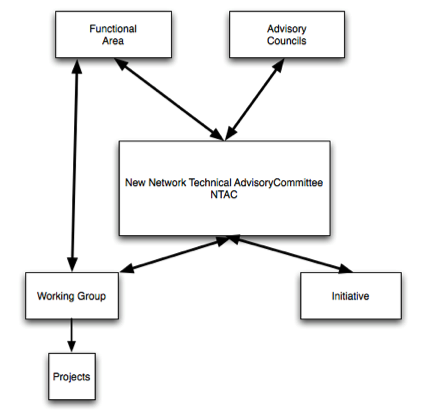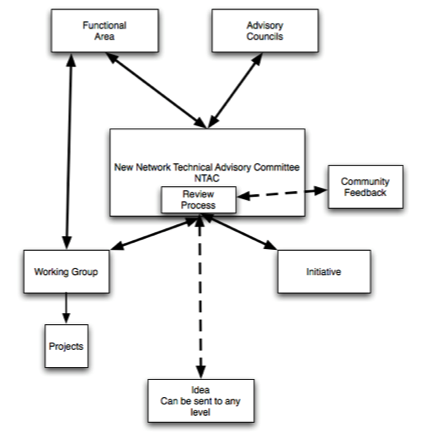
Figure 1: Relationships
|
RECOMMENDED FRAMEWORK |
Internet2 held its first Community Design Workshop in June 2006 to discuss the design of its proposed next generation network and to solicit community input. One outcome of those discussions was the creation of a temporary advisory group called the Internet2 Network Advisory Group (NAG). This group was charged with outlining recommendations for a new technical advisory structure to facilitate the design, deployment, and development of the new Internet2 network (NewNet). As part of its charge, NAG was asked to provide recommendations on the makeup of a new Network Technical Advisory Committee (NTAC), how its members should be selected, NTAC's relationship to the overall structure of Internet2, and how to ensure efficient and effective communications between NTAC and other facets of Internet2's advisory structure. NAG was also asked to ensure its recommendations encouraged and accommodated ongoing community input and involvement and provided transparency into technical advisory processes and decisions.
NAG was establishedin late June and asked to provide its recommendations by August. The group conducted its business over the course of 6 weekly conference calls and via email. Given the time constraints as well as Internet2's urgent need for a basic technical advisory framework to support the impending deployment of NewNet, the group elected to characterize its discussions in the form of a brief outline rather than a more elaborate report. However, the group remains available to clarify, revisit, or discuss any of the recommendations highlighted below.
1. NewNet is substantially more capable and complex than Abilene. Greater breadth of technical expertise will therefore be required to grapple with it deployment, operation, and development. Anticipated areas of expertise requiring representation on NTAC include but are not necessarily limited to optronics at layer 1, switching at layer 2, IP-based routing at layer 3, middleware, applications, and security. NTAC may identify other technical domains where representative expertise might be required.
2. NTAC should be granted the latitude to self-organize, to determine its structure and the specific makeup of its membership, and to establish the criteria and qualifications for member selection. Our recommendations on the composition of NTAC are therefore not prescriptive. However, we do recommend that the composition of NTAC be reasonably representative, including participation from the campuses, connectors (i.e., gigapops), regional aggregators (i.e., RONs), and vendors and service providers, among others constituents.
3. NTAC member terms should span three years with an option to extend participation for a second three year term. After serving a second term, participants may return to NTAC after a one year hiatus.
4. The first NTAC members will need to be established by an external nominating committee, such as the Internet2 Governance and Nominations Committee. Thereafter, NTAC should determine the specific mechanisms by which its members are selected during its self- organizational phase. Whatever the resulting process may be, it should always be inclusive and transparent. NTAC membership criteria should be clearly stated and communicated to the community, nominations for membership should be open to all, and community input on the suitability and qualifications of nominees should be solicited. Final decisions on NTAC membership should be made through a process which includes both Internet2 members and staff, but the membership should have a dominant role.
5. NTAC should have efficient and effective working relationships and communication channels with Internet2 advisory councils, functional area directors, working groups, and any other NewNet-related entities and initiatives. For example, NTAC should be able to request assistance from the appropriate advisory council whenever a technical issue requires policy review, and NTAC should be solicited by the advisory councils whenever policy or other issues have technical implications. Internet2 should provide support staff to NTAC in order to help ensure that communications between NTAC and other Internet2 entities and the community is timely, consistent, efficient, and effective.
6. NTAC should retain the same basic relationships to its functional area directors and working groups as does the current Abilene TAC. Relationships and communication channels surrounding NTAC should be bidirectional with the overall advisory structure, the functional directors, and with working groups and initiatives, as characterized in Figure 1: Relationships.
 Figure 1: Relationships |
7. NTAC should be able to charter short- and long-term working groups associated with various NewNet-related projects and activities. Initial working groups should include Multicast, IPv6, Measurement, Security, Hybrid Networking, the NewNet Observatory, and CALEA. 8. The community should have convenient, consistent, transparent, and systematic means to provide input and recommendations to NTAC and Internet2. Toward this end, NTAC should adopt an IETF-like RFC mechanism for idea and/or proposal propagation and review. NTAC would then review submissions and dispatch them accordingly—e.g., back to the authors for refinement, to the community for comments, or to Internet2 for subsequent consideration, as characterized below in Figure 2: Community Input.
 Figure 2: Community Input |